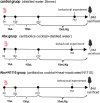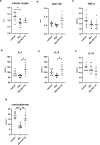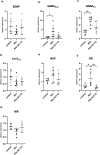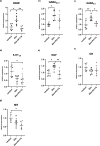Heat-inactivated Lacticaseibacillus paracasei N1115 alleviates the damage due to brain function caused by long-term antibiotic cocktail exposure in mice
- PMID: 35754018
- PMCID: PMC9233843
- DOI: 10.1186/s12868-022-00724-w
Heat-inactivated Lacticaseibacillus paracasei N1115 alleviates the damage due to brain function caused by long-term antibiotic cocktail exposure in mice
Abstract
Critical development period of intestinal microbiota occurs concurrently with brain development, and their interaction is influenced by the microbiota-gut-brain axis. This study examined how antibiotics exposure affected gut microbiota and brain development and analyzed the possible benefits of heat-inactivated Lacticaseibacillus paracasei N1115 (N1115). Thirty neonatal male mice were randomly divided into three groups and treated with sterilized water (control), an antibiotic cocktail (Abx), or antibiotics plus heat-inactivated N1115 (Abx + N1115) for 84 days. We found that while the mRNA levels of GABAAα1, GABAb1, and glucocorticoid receptor (GR) in the hippocampus and brain-derived neurotrophic factor (BDNF), GABAAα1, GABAb1, and nerve growth factor (NGF) in the prefrontal cortex were higher, the mRNA levels of 5-HT1A were lower in the Abx group. The Abx + N1115 group had lower mRNA levels of GABAAα1, GABAb1, and GR in the hippocampus and BDNF, GABAb1, and NGF in the prefrontal cortex than the Abx group. The latency period was longer in the Morris water maze test while longer rest time was seen in tail suspension test in the Abx group than the control and Abx + N1115 groups. In the open field test, the moving time and distance of the Abx group were reduced. Further, the alpha-diversity indexes of the Abx and Abx + N1115 groups were significantly lower than the control. Further, long-term exposure to antibiotics disrupted the intestinal microbiota as evidenced by decreased Bacteroides, Firmicutes, and Lactobacillus, and increased Proteobacteria and Citrobacter. However, N1115 significantly decreased the abundance of Citrobacter when compared with those in the Abx group. These results indicate that antibiotics can substantially damage the intestinal microbiota and cognitive function, causing anxiety and depression, which can be alleviated by heat-inactivated N1115 via modulation of the microbiota-gut-brain axis.
Keywords: Antibiotic; Cognitive function; Microbiota–gut–brain axis; Paraprobiotic.
© 2022. The Author(s).
Conflict of interest statement
The authors declare that they have no competing interests.
Figures







Similar articles
-
[Macrophage-Activated Products of Lacticaseibacillus paracasei N1115 Promote the Development of Primary Hippocampal Neurons].Sichuan Da Xue Xue Bao Yi Xue Ban. 2024 Sep 20;55(5):1150-1158. doi: 10.12182/20240960504. Sichuan Da Xue Xue Bao Yi Xue Ban. 2024. PMID: 39507971 Free PMC article. Chinese.
-
Effect of heat-inactivated Lactobacillus paracasei N1115 on microbiota and gut-brain axis related molecules.Biosci Microbiota Food Health. 2020;39(3):89-99. doi: 10.12938/bmfh.2019-025. Epub 2020 Feb 19. Biosci Microbiota Food Health. 2020. PMID: 32775126 Free PMC article.
-
Antibiotic cocktail-induced gut microbiota depletion in different stages could cause host cognitive impairment and emotional disorders in adulthood in different manners.Neurobiol Dis. 2022 Aug;170:105757. doi: 10.1016/j.nbd.2022.105757. Epub 2022 May 16. Neurobiol Dis. 2022. PMID: 35588989
-
Myelin as a regulator of development of the microbiota-gut-brain axis.Brain Behav Immun. 2021 Jan;91:437-450. doi: 10.1016/j.bbi.2020.11.001. Epub 2020 Nov 4. Brain Behav Immun. 2021. PMID: 33157256 Free PMC article.
-
The effect of antibiotics on the intestinal microbiota in children - a systematic review.Front Allergy. 2024 Oct 7;5:1458688. doi: 10.3389/falgy.2024.1458688. eCollection 2024. Front Allergy. 2024. PMID: 39435363 Free PMC article.
Cited by
-
Gut dysbiosis induces the development of depression-like behavior through abnormal synapse pruning in microglia-mediated by complement C3.Microbiome. 2024 Feb 20;12(1):34. doi: 10.1186/s40168-024-01756-6. Microbiome. 2024. PMID: 38378622 Free PMC article.
-
The role of probiotics, prebiotics, and postbiotics: cellular and molecular pathways activated on glial cells in Alzheimer's disease.Front Neurosci. 2025 Jun 25;19:1598011. doi: 10.3389/fnins.2025.1598011. eCollection 2025. Front Neurosci. 2025. PMID: 40636703 Free PMC article. Review.
-
Probiotics and Fecal Microbiota Transplantation in Major Depression: Doxa or Episteme?Adv Exp Med Biol. 2024;1456:67-83. doi: 10.1007/978-981-97-4402-2_4. Adv Exp Med Biol. 2024. PMID: 39261424 Review.
-
Live and Heat-Inactivated Streptococcus thermophilus MN-ZLW-002 Mediate the Gut-Brain Axis, Alleviating Cognitive Dysfunction in APP/PS1 Mice.Nutrients. 2024 Mar 15;16(6):844. doi: 10.3390/nu16060844. Nutrients. 2024. PMID: 38542758 Free PMC article.
-
[Macrophage-Activated Products of Lacticaseibacillus paracasei N1115 Promote the Development of Primary Hippocampal Neurons].Sichuan Da Xue Xue Bao Yi Xue Ban. 2024 Sep 20;55(5):1150-1158. doi: 10.12182/20240960504. Sichuan Da Xue Xue Bao Yi Xue Ban. 2024. PMID: 39507971 Free PMC article. Chinese.
References
MeSH terms
Substances
LinkOut - more resources
Full Text Sources
Medical

